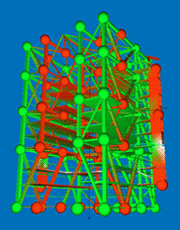MEASUREMENT OF THE STATIC STRESS STRAIN BEHAVIOR OF STRUCTURES
Changes in structures may be caused by poor quality of construction materials, flawed design and construction, uneven settling of engineering structure foundation, miscalculations in design of loads, etc.
The strain measurement method is based on determining stresses and deformations in the outer layers of parts using the ZET 7010 Tensometer-485, ZET 7110 Tensometer-CAN, ZET 7111 Tensometer-CAN measuring modules or ZET 017-T8 strain gauge station and ZETLAB software. Strain sensors and resistive strain sensors of various designs can be used as sensing elements. The main advantage of the resistive strain measurement is that the strain can be measured without any mechanical impact on the object.
Distributed strain measuring system
— Smart (digital) strain sensor (strain sensor primary transducers + ZET 7010 measuring module).
— ZET 7070 interface converter.
— A computer with ZETLAB SENSOR software installed.
Distributed measuring systems, as opposed to the traditionally used centralized systems, do not require a “star” connection, which makes the overall circuit shorter. Such a feature of the distributed measuring network allows for its use in the tower structure control, installation loads monitoring in the automotive industry, in rail car, crane, hopper weighing systems, etc.
Let’s consider a distributed measuring system exemplified by control of the mobile service tower (MST) required for vertical assembly of the launch vehicle and the rocket head.

To detect deformations in the MST, smart sensors should be used, since a centralized system is hard to implement for the mobile service tower due to its complicated structure.
The digital strain sensors are sensing elements of the measuring system and are fixed directly onto the tested structure. One of the digital strain sensor features is that the primary transducer characteristics and the test object profile are stored in the measuring module memory. This way, the use of digital strain sensors makes it possible to start measuring right away.
The data retrieved from the smart sensors are transmitted via the ZET 7070 interface converter to a computer with the ZETLAB SENSOR software installed for subsequent processing by the virtual devices.

Sensors installed all over the MST. The deformations in the structure are shown in red
The ZETLAB SENSOR software supplied with the ZET 7070 PC transmission module allows to:
- Display the time realization of signals in the planes and in the space;
2. Measure the signal parameters;
3. Record the instantaneous digitized values or selected signal parameters;
4. Playback the recorded signals;
5. Convert the files and data from the binary into text format;
6. Analyze the signal spectrum;
7. Perform arithmetic, mathematical, and logical operations with the data;
8. View and set the digital sensor parameters.
